#Metropolitan Cammell
Video
1971 - Belle of the ball by Bingley Hall
Via Flickr:
Unfortunately taken on dubious film stock, this transparency has not weathered the test of time well, but it's rarity value saves it. The 'Brighton Belle' electric Pullman service arrives at London's Victoria station with an up service from Brighton sometime during 1971. Three 5-car 750v DC, third rail, all Pullman electric multiple units were built for the Southern Railway in 1932 and worked the service in either single or double unit formations. It lost its classic umber and cream Pullman livery in 1969 and the service and units were withdrawn in April 1972.
#Transport#train#Transportation#Rail#railway#Railroad#electric#UK#Britain#England#Third rail#750V#DC#EMU#electric multiple unit#Brighton Belle#Pullman#5-BEL#Victoria#Metropolitan Cammell#Class 403#British Rail#BR#passenger#flickr#trainspam
8 notes
·
View notes
Video
LT trolleybus No. 1741 on service 695 - Feb 1949 by Frederick McLean
Via Flickr:
An old photograph of London Transport (LT) SA2 class trolleybus No. 1741 (registration GLB741) on Romford Road (Michigan Avenue on the left), Manor Park, showing '695 - Bow Church via Ilford' destination blinds. Trolleybus route 695 closed in Jan 1959. The photo reverse is stamped with "Alan B. Cross", and dated 19 Feb 1949. Thanks to Jon 'JB (KK 69521)' for the location and modern day view:- "Looks like Romford Road, Manor Park, about here" goo.gl/maps/KwJ7iFft78tNhpHs6 Old/new overhead maps view:- maps.nls.uk/geo/explore/side-by-side/#zoom=18.0&lat=5... No. 1741 was originally for export to Durban in Sth. Africa, but due to trolleybus shortages it was diverted for home use in London. It was new to LT in Jun 1942 operating out of Ilford Depot and comprised a Leyland TTB triple axle chassis and a Metropolitan-Cammell body seating 72 (H40/32R). It was withdrawn from service in Aug 1959 after stage 3 (18/19 Aug) of the trolleybus conversions, and in Feb 1960 was sold to George Cohen & Son for scrap. The parts of the London trolleybus system that had not already been withdrawn or transferred to bus operation closed in May 1962. If there are any errors in the above description please let me know. Thanks. 📷 Any photograph I post on Flickr is an original in my possession, nothing is ever copied/downloaded from another location. 📷 -------------------------------------------------
#trolleybus#LT trolleybus#London trolleybus#London Transport#London Passenger Transport Board#London#GLB741#Leyland trolleybus#Metro Cammell#Metropolitan Cammell#old photograph#old transport#old trolleybus#vintage transport#vintage photograph#vintage trolleybus#Alan B Cross#flickr
0 notes
Video
The Blue Pullman train (Metropolitan Cammell) by Historical Railway Images
Via Flickr:
Original large format official transparency of the Blue Pullman passenger train
4 notes
·
View notes
Text
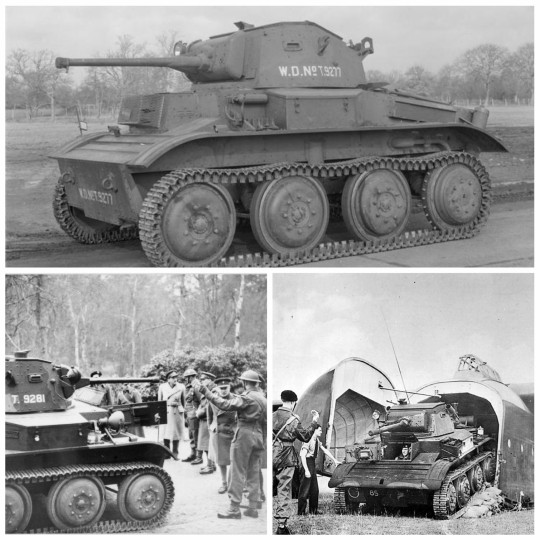
• Light Tank Mk VII Tetrarch
The Light Tank Mk VII (A17), also known as the Tetrarch, was a British light tank produced by Vickers-Armstrongs in the late 1930s and deployed during the Second World War.
The prototype of the Light Tank Mk VII (A17), nicknamed 'Purdah', was first developed in 1937 by Vickers-Armstrongs as a private venture, and was intended to be sold either to the British Army or to foreign militaries. It was to be the latest in a series of light tanks produced by the company. The tank was designed to overcome the shortcomings of insufficient armament in earlier light tanks that were fitted only with machine guns. Vickers-Armstrong installed on the Mk VIIs a 2-pounder 40-millimetre (1.6 in) main gun paired with a 7.92-millimetre (0.312 in) Besa machine gun, and mounted the two guns in a two-man turret. The prototype weighed approximately 16,800 pounds (7,600 kg) and was powered by a 165-horsepower (123 kW) Meadows engine. Suspension was on eight road wheels, four per side, with no separate driver or idler wheels and it was capable of a 40 miles per hour (64 km/h) top speed. The Mk VII design relied on an unusual steering method and a mechanical system incorporated into earlier Vickers models. The front wheels could be steered to allow for gentle turns by bending the tracks. For sharper turns, the system returned to the conventional method of braking one track to turn the tank; the dual system of turning was designed to lessen mechanical strain on the MkVII and reduce its power wastage. The War Office examined the design and put the prototype through a series of trials during May and June 1938; the model was tested as a possible "light cruiser" since War Office light tank needs were already met by its predecessor, the Mark VI. The War Office then took the view that the tank was not acceptable as a light cruiser because the Nuffield A13 offered better speed and obstacle crossing performance. Despite this, it was decided that it was essential for some Tetrarchs to be produced, and it was suggested that they be brought in at the end of the light tank program.
Accordingly, the War Office gave the Tetrarch the official General Staff specification number A17, and, in November 1938, accepted it for limited production after requesting a few minor changes which included the fitting of an external fuel tank to increase the tank's range. The number to be produced was subject to fluctuation as the War Office vacillated in their demand; in July 1938, it requested that 70 of the tanks be produced, then increased the request to 120 after a three-day conference in November. Production began in 1940, the request number further increased to 220 after Metropolitan Cammell Carriage and Wagon, a company part owned by Vickers-Armstrong that would be producing the tanks, indicated it had already ordered armour plating for that many tanks. Production of the tank was delayed by a number of factors. The War Office put their order on hold in a post-Battle of France decision to focus military production on infantry and cruiser tanks, due to the poor performance of British light tanks during that battle. Due to the shortage of more suitable tanks, light tanks that were not designed for use against German armour, were nevertheless deployed against them; the resulting high casualties led the War Office to re-evaluate the suitability of the light tank design. Further delays were caused by the bombing raids of the Luftwaffe during May 1941 against the factories where the tanks were assembled. The cumulative effect of these delays resulted in the production of only a small number of Mk VIIs; estimates place the final total produced to be between 100 and 177. The name 'Tetrarch' was given to the Mk VII, on September 22nd, 1941, on the orders of the War Office. The last of the tanks were built in the first quarter of 1942 and delivered at the end of the year.
The War Office and the Army were concluding, at this point, that light tanks were a liability and too vulnerable for use in further combat, and the Tetrarch was considered to be obsolete. This decision may have marked the end for the Tetrarch in active service; several of the tanks destined to be deployed to the Eighth Army in the Middle East for the North African Campaign were left in Britain when their cooling systems were determined to be unable to cope with the intense North African heat. The demise of Tetrarch was prevented by a decision made by the War Office in mid-1941, as it was considering the equipment to be used by Britain's fledgling airborne forces, formed in June 1940 under the orders of the Prime Minister, Winston Churchill. When selecting the equipment for the airborne forces, officials at the War Office concluded that gliders would be an integral component; gliders would transport troops and heavy equipment, which, by 1941, was to include artillery and some form of tank. By May 1941, the feasibility of a 5.5 metric tons (5.4 long tons) tank to be carried for 350 miles (560 km) in a glider was accepted, although the aircraft would have to be specifically designed for the task. In a conference held on January 16th, 1941, it was decided that the General Aircraft Hamilcar, currently under development, would be used to transport a single Tetrarch tank or two Universal Carriers. The Tetrarch was chosen because it was an obsolete design, and was therefore available to be used by the airborne forces.
Beginning in January 1944, training exercises were conducted carrying the Tetrarchs and their crews inside Hamilcar gliders. These exercises were successful; during the training by 'C' Squadron of the Glider Pilot Regiment, which specialised in flying the Hamilcars, over 2,800 lifts were made with an average of 50 lifts per crew. When the Tetrarch was re-designated as an airborne tank, several changes were made to its design. A number of tanks had their 2 pounder guns replaced with a 76.2-millimetre (3.00 in) infantry support howitzer; these tanks were then designated as Tetrarch 1 CS (Close Support). Additionally, Littlejohn adaptors were added to those Tetrarchs which still possessed their 2 pounders to increase their muzzle velocity and armour penetration. The Tetrarch experienced several setbacks throughout its development and deployment with the Army and airborne forces. One of the major problems was the limited number of these tanks that existed after production ended in 1942, which particularly affected the airborne forces. The transport of 20 of the tanks to the USSR under the Lend-Lease Act depleted the number available for use by airborne forces, as did the loss of several more during the invasion of Madagascar. This lack of sufficient replacement reserves, combined with a War Office report that some 287 airborne tanks would be required for the 1st Airborne Division and an unnamed airborne division to be formed in India, led to the Tetrarch's eventual replacement by the US M22 Locust.
A number of design faults of the Tetrarch were revealed through its operational use. Its size limited the possible crew to three, a driver in the hull and a gunner and commander in the turret, resulting in too few crew members to operate the Tetrarch effectively. The gunner or commander, in addition to his own duties, had to act as loader for the 2 pounder, which caused delays in combat. A report on the tank written in January 1941 stated that as the commander had to both fight and control the tank, controlling a troop of Tetrarchs during combat would be almost impossible. Problems were also found with the Littlejohn adaptor fitted to the 2-pounder to increase its range and penetration power; after they had been fitted the adapters could not be removed, and could only fire specially designed armour-piercing rounds, which took time to manufacture. The War Office also considered the Tetrarch's cooling system faulty, making the tank unsuitable for service in hotter climates, such as the Middle East and North Africa. The first Tetrarchs were delivered to the Army in November 1940, and were initially deployed with the 1st Armoured Division (which was being refitted after losing the majority of its previous tanks during the Battle of France) and the newly formed 6th Armoured Division. However, the faults discovered with the Tetrarch cooling system precluded them from being integrated into units in North Africa Campaign. Shortly after, all light tanks were discarded from the establishments of British armoured divisions as not suitable for further service. The Tetrarchs remained in Britain, and would probably have been used as training vehicles before being retired from service, but in June 1941 the German invasion of the USSR, Operation Barbarossa began, and the USSR became an ally of Britain. As part of the lend-lease program, the British government began supplying war materials to the USSR, which in early 1942, included a shipment of 20 Tetrarchs, as well as a number of Valentine and Matilda Mk I Infantry tanks. The Soviet military utilised a greater number of light tanks than the British, and so could use the Tetrarchs. When the tanks arrived in the USSR, however, it was apparent that the design problems with the cooling system were also present in cold conditions; additionally, the cold weather had a deleterious effect on the tank's suspension and tracks. Additional testing of the Tetrarchs was conducted by the Soviet military and the design was admired for its controllability, manoeuvrability, and speed, as well its ability to run on low-quality fuel, unlike contemporary Soviet designs. The thinness of the Tetrarch's armour was found to be a problem and one which could not be solved, as the weight of extra armour plating caused an unacceptable reduction in the tank's speed.
Despite these drawbacks in the Tetrarch's design, Soviet authorities believed it to be comparable to the T-70 light tank in use at the time, and decided that it was suitable to be used in combat. in September 1943 two were assigned to the 132nd Separated Tank Battalion, which was attached to the 5th Guards Tank Brigade; both tanks were destroyed in combat. Several were also used for propaganda purposes, appearing in photographs of Soviet troops who were fighting in the Caucasus region. In mid-1941, the Royal Armoured Corps in Britain created three tank squadrons for special overseas operations, known as 'A', 'B' and 'C' Special Service Squadrons. Both 'A' and 'B' Squadrons were equipped with Valentine Infantry tanks and Mark VIc light tanks, but 'C' Squadron was equipped with twelve Tetrarchs transferred from the 2nd Armoured Brigade, 1st Armoured Division. All three squadrons were transported to Inverary in Scotland for intensive training that focused on embarkation and disembarkation from ships and landing craft to prepare them for action in potential amphibious operations. Operation Ironclad, was the invasion of Madagascar, the third largest island in the world and then under Vichy French control. The 29th Brigade formed the core of the invasion force due to its training in amphibious operations, and under its command was 'B' Special Service Squadron, created by amalgamating six Valentines from 'B' Squadron and six Tetrarchs from 'C' Squadron into a single unit. The squadron was formed into four troops, one Headquarters troop of three Valentines and one Tetrarch, one of four Valentines, and two formed from the remaining five Tetrarchs. The invasion force assembled off the west coast of the northern tip of Madagascar on May 4th, near Antsirane and the bay of Diego Suarez. The French line was eventually broken by 29th Brigade, aided by an amphibious assault by Royal Marines; the remaining tanks of 'B' Squadron, two Valentines and three Tetrarchs. The squadron played no further part in the battle, as the Vichy French authorities negotiated a formal surrender the following day, although French troops would continue to engage the British occupying force in guerrilla warfare until late November. 'C' Squadron suffered heavy casualties during the invasion; only one Valentine and three Tetrarchs out of twelve tanks were functional by May 7th, and the squadron had suffered seven killed and six wounded. It remained in Madagascar until early 1943, when it was shipped to India and took part in the Burma Campaign as part of 29th Brigade.
Because of a lack of equipment training facilities in mid-1940, when the British airborne establishment was formed, the War Office was able to accept only 500 volunteers for training as airborne troops. Progress in setting up proper training facilities and acquiring suitable transport aircraft was so slow that the first British airborne operation, Operation Colossus, was conducted by a retrained Commando unit. The 1st Airborne Division, and on January 19th, 1942 the War Office decided that a light tank unit would be one of the support units attached to the division. This unit, designated the Light Tank Squadron, was to be formed of nineteen light tanks and would operate to the fore of the division, using their tanks' speed to capture objectives and then holding them until relieved by other units. The unit immediately began training, but was not attached to the 1st Airborne Division for long; during mid-1943, the division was transported to the Middle East so it could participate in the Allied invasion of Sicily. The squadron was transferred to the 6th Airborne Division, which had been raised in April 1943, and 'C' Squadron remained with it for the rest of the conflict. The squadron continued to train as an air-portable unit, and participated in a number of exercises to prepare for its new duties, including reconnaissance of enemy positions and counter-attacking enemy infantry and armour. In December 1943, the War Office decided to expand the squadron into a regiment equipped with a combination of light tanks and conventional reconnaissance vehicles such as scout cars, and on April 1st, 1944, it was re-designated as the 6th Airborne Armoured Reconnaissance Regiment. In May 1944, after participating in a further series of exercises and manoeuvres, 'A' Squadron moved from their training area to a transit camp at Tarrant Rushton airfield, while the rest of the regiment moved to RAF Brize Norton airfield the next day; from these two airfields, the regiment would be transported from to participate in the British airborne landings in Normandy. It was tasked with protecting the eastern flank of the Allied seaborne landings, securing strategically important areas east of Caen, capturing several important bridges over the Caen Canal and River Dives, and destroying a coastal artillery battery. Insufficient transport aircraft were available to land all three of the division's brigades simultaneously; one would have to be landed in a second lift later. The Tetrarchs of 'A' Squadron were to play an integral part in this reconnaissance role due to their speed, but the squadron's strength of twenty tanks was severely depleted by the time it landed in Normandy. The squadron's strength was further weakened when two gliders collided with each other in the landing zone, destroying themselves and the Tetrarchs they carried; a third Hamilcar hit another Tetrarch as it was being unloaded and flipped the tank upside down, rendering it unusable, although the crew escaped without injury. The surviving tanks were then rendered temporarily immobile when parachute rigging lines became tangled in their suspensions, forcing their crews to cut the lines away with welding torches.
The squadron retrieved all of the remaining Tetrarchs and advanced to the south of the landing zone to link up with the rest of the regiment; there, they received orders to support the 8th Parachute Battalion in the Bois de Bavent area and conduct reconnaissance duties. The division was reinforced by British troops who were advancing from the invasion beaches and it began to push through Normandy, while the squadron continued its reconnaissance duties. Instead, when the division required armoured support, it summoned it from armoured units outside the division, and the Tetrarchs were used to support infantry patrols and provide fire support. By August, in the division's preparation for the planned breakout from the Normandy bridgehead, the majority of Tetrarchs in 'A' Squadron were replaced with Cromwell fast cruiser tanks; only three Tetrarchs remained, assigned to the Headquarters troop of 'A' Squadron. Operation Tonga was the last that Tetrarchs saw of active combat. During the first week of October 1944, the 6th Airborne Armoured Reconnaissance Regiment underwent an extensive reorganization, in which it was completely restructured, and all the remaining Tetrarchs were retired.
They were replaced with the M22 Locust, a purpose-built airborne light tank of American design; eight Locusts were used by the regiment in March 1945 during Operation Varsity, the airborne operation to cross the river Rhine. A report issued by the Director (Air) of the War Office in January 1946 confirmed that the Tetrarch design was considered obsolete, and any light tanks used in post-war airborne formations would be entirely new in design. A small number of Tetrarchs remained in service with the 3rd Hussars until 1949; a Hamilcar glider flight was stationed at RAF Fairford, and a troop of Tetrarchs was kept by the regiment for training exercises with the gliders. However, glider training by the regiment was stopped in 1950 and the Tetrarchs withdrawn from service. Surviving Tetrarch are on display at Bovington and Kubinka.
#world war 2#second world war#world war ii#military history#wwii#history#british history#long post#tank warfare#tanks#military equipment#british tanks
22 notes
·
View notes
Text
Pullman
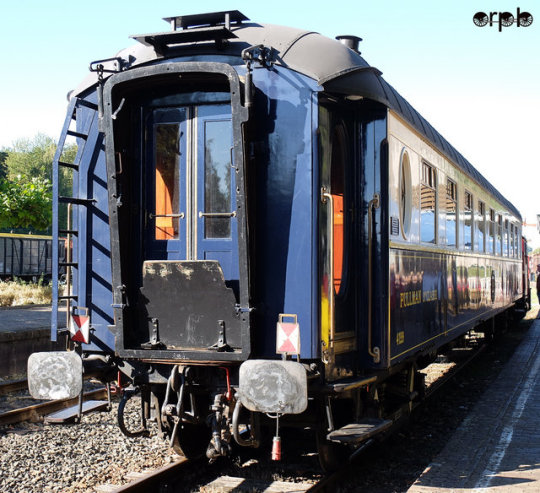
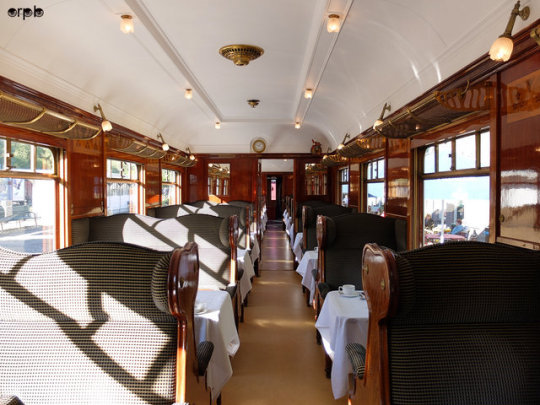
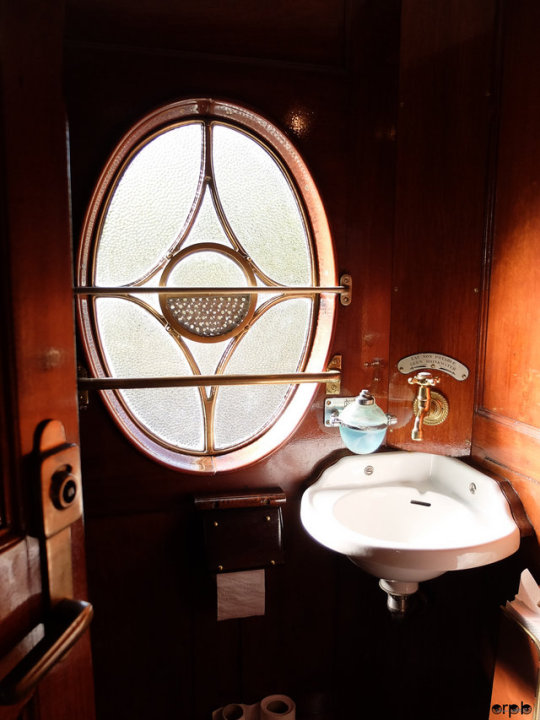

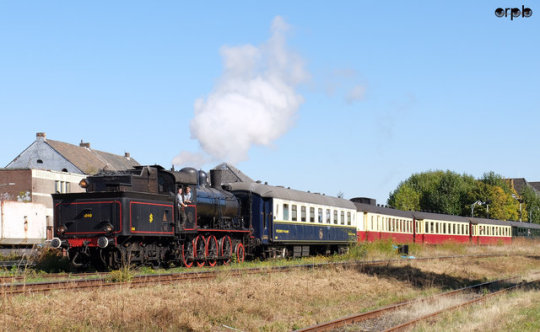
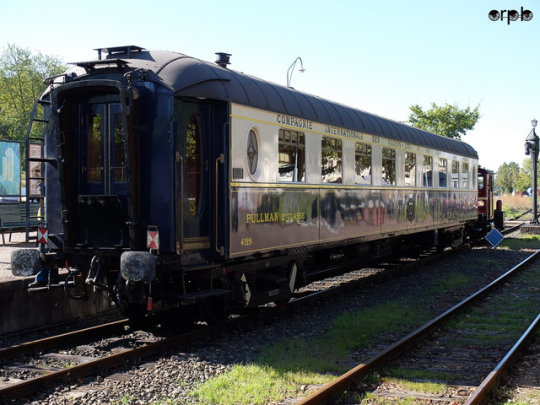
Pullman-Wagen Zuid Limburgse Stoomtrein Maatschappij (ZLSM) (Südlimburgische Dampfeisenbahn-Gesellschaft) Simpelveld (NL)
erbaut 1927 von Metropolitan Cammell Carriage & Wagon Co Ltd in Birmingham. Liebevoll restauriert und wieder aufgebaut durch ZLSM in Simpelveld.
Pullman wagon Zuid Limburgse Stoomtrein Maatschappij (ZLSM) (South Limburg Steam Train Company) Simpelveld (NL)
built 1927 by Metropolitan Cammell Carriage & Wagon Co Ltd in Birmingham. Lovingly restored and rebuilt by ZLSM in Simpelveld.
#dampflokblog.de#railway#dampflok#steam train#steam locomotive#stoom locomotief#eisenbahn#railway museums & depots#lokomotywa#локомотив#eisenbahnmuseen & betriebshöfe#lokomotive#stoomtrein#locomotive#simpelveld#pullman#zlsm
38 notes
·
View notes
Photo


On The Rails - First Gen DMUs
Metro-Cammell 'Lightweight'
“In 1955, Metropolitan Cammell produced its first lightweight Diesel multiple units, the prototypes of what were to become British Rail's most successful and longest-lived First Generation DMU type, the Class 101.
They proved to be very successful, but with line closures continuing through the 1960s, including many in East Anglia where the type was first used, their non-standard coupling arrangements left them prone to early withdrawal, which took place during 1967–1969.
All were scrapped following withdrawal, except two (79047 + 79053), which were taken into departmental (non-revenue earning) service as 975018 + 975019. They were used at the Railway Technical Centre in Derby as ‘Laboratory 21: Plasma Torch Research’. When this extended life was complete, they too were scrapped, in 1981.”
1 note
·
View note
Text

【都城嘉慕列車】圖為九十年代地下鐵,都城嘉慕(Metro Cammell England)列車仍未被「翻新」,車廂色調仍以暖色為主。
都城嘉慕為英國鐵路車輛生產商,一九二九年由Metropolitan Vickers Limited及Cammell Laird的鐵路部門合併後成立,總部位於伯明翰。香港地下鐵路、九廣鐵路英段電氣化首批列車,均向其訂購,運行至九十年代後期陸續翻新;其中地下鐵經典「白頭」和九鐵「黃頭」,分別換成銀白色M Train及「烏蠅頭」。
這批都城嘉慕列車在香港運行數十載後,已進入逐步退役階段,其中港鐵M Train預計至2027年全數退役。
至於它們的生產商其實更早走入歷史,1989年都城嘉慕陷入財政危機,同年5月,鐵路部被法國的通用電力阿爾斯通收購。在2005年製造最後一輛列車後正式關閉。
0 notes
Text
18 of the World’s Most Delightful Airport Features
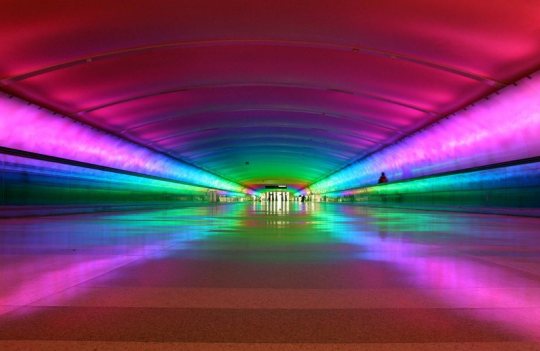
Airports can be busy, stressful, and sometimes, awesome. Dawn Huczek/CC BY 2.0
There was apparently a time, in some far-off age, when commercial air travel was exciting and fun. Today, it’s easy to understand why most people now feel that airports are dreaded prisons of bureaucracy and inconvenience. And yet, even as airports have turned decidedly toward the dystopian, one can still find awesome surprises in bustling terminals across the globe. We recently asked Atlas Obscura readers in our Community forums to tell us about the most wondrous attractions they’ve ever encountered in an airport, and their responses made us want to arrive for our flights even earlier than before.
From psychedelic neon tunnels to sandy beach runways, our readers sent us a first-class selection of unbelievable airport features. Take a look at some of our favorite recommendations below, and if you have an incredible airport oddity of your own that you’d like to share, head over to the forums and keep the conversation going! Flying might not seem as wondrous as it once was, but airports can still amaze.
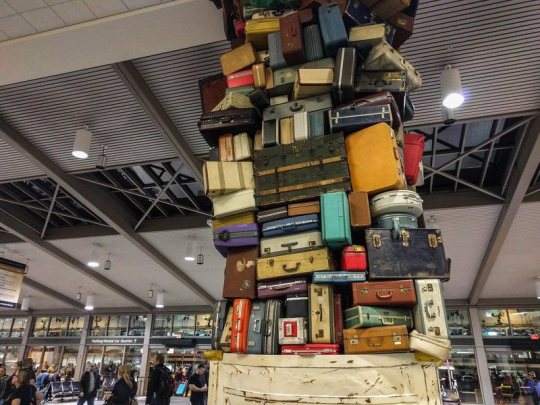
Tony Webster/CC BY-SA 2.0
Sacramento International Airport (SMF)
“These fantastic pillars of luggage in baggage claim at the Sacramento Airport are a wonderful example of environmental-friendliness: reuse, reduce, recycle.” — AnyaPH

Captison/CC BY-SA 3.0
General Mitchell International Airport (MKE)
“Mitchell Field in Milwaukee has Renaissance Books—used and rare books. If you didn’t pack sufficient reading material, this is the place to get a good book. When I lived in the northern part of Illinois, I’d always use Mitchell when I could, not least because of Renaissance Books.” — JLP60615
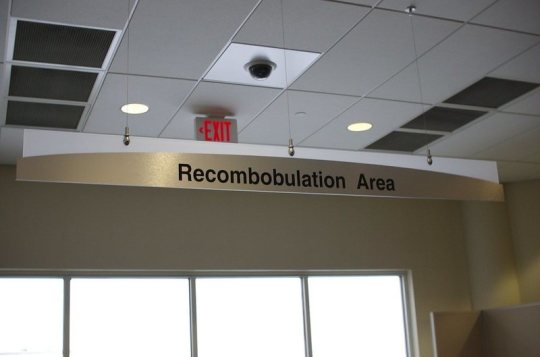
Joe/CC BY 2.0
Recombobulation Area
General Mitchell International Airport (MKE)
“In Milwaukee, after you take off your shoes and belt to go through security, put yourself back together in the ‘Recombobulation Area.’” — pinchanygo
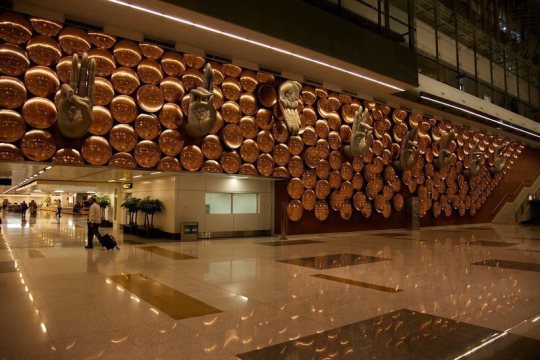
David Brossard/CC BY-SA 2.0
Mudra Sculptures
Indira Gandhi International Airport (DEL)
“First trip to India (#AtlasObscura) in March. Blown away by wall-to-wall metal discs and beautiful hand mudras in the Delhi Airport.” — marys826
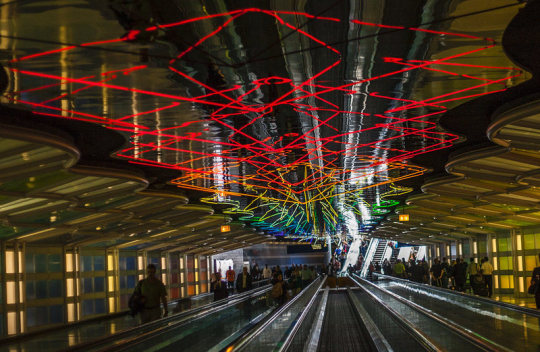
Paul VanDerWerf/CC BY 2.0
‘Sky’s the Limit’
Chicago O’Hare International Airport (ORD)
“Chicago O’Hare has a fantastic tunnel between terminals. Which I personally think they need to hang gold coins above to complete the video game chic.” — Bumpy
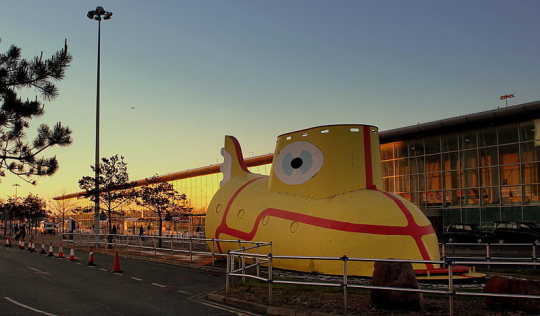
calflier001/CC BY-SA 2.0
The Yellow Submarine
Liverpool John Lennon Airport (LPL)
“Always loved this yellow submarine outside John Lennon Airport in Liverpool. Built by one of the biggest ship builders in Liverpool (Cammell Laird), it even contains genuine submarine equipment on the inside.” — ollieclark96
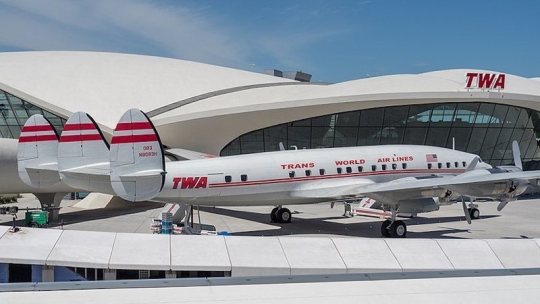
Jag9889/CC BY-SA 4.0
John F. Kennedy International Airport (JFK)
“JFK Airport in New York has a new spectacular oddity! The historic TWA terminal, designed by Eero Saarinen, has been turned into a hotel (an oddity in itself) and they’ve now adorned it with a restored Lockheed Constellation L-1649A, known as ‘Connie.’ It’s one of only four of these aircraft remaining in the world.” — Philip_Shane
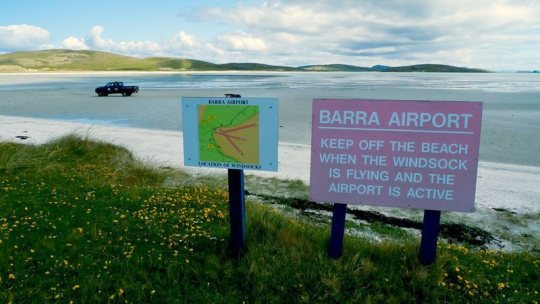
Simaron/CC BY-SA 2.0
Barra Airport (BRR)
“Landing on the beach in Barra [in Scotland] is pretty special.” — Kenneth_Wardrop
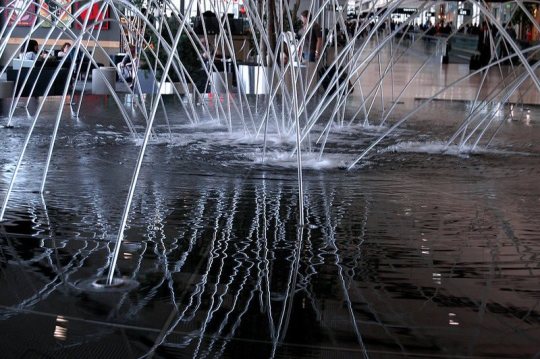
Joanna Poe/CC BY-SA 2.0
Laminar Flow Fountain
Detroit Metropolitan Airport (DTW)
“The fountain in DTW Terminal A is also very interesting. In a city known for engineering, the fountain employs a few cool engineering features. The water jets come from laminar flow nozzles, so it looks like noodles or little hot dogs of water jump across the fountain surface. Water flows over the entire edge of the circular fountain, but instead of having a sharp edge for the water to fall over, the fountain curves back underneath itself. Surface tension causes the water to cling to the surface, so it appears that the water is defying gravity. I always chuckle when I see people leaning up against the fountain edge, only to walk away with a wet line across the front of their pants.” — tiretester

JasonParis/CC BY 2.0
Light Tunnel
Detroit Metropolitan Airport (DTW)
“Detroit’s airport (DTW) is my favorite place for a layover. Airplane travel can be harsh and disorienting, but Detroit’s rainbow tunnel is truly restorative. The rainbow tunnel (possibly not its official name) connects the airport’s two terminals via an underground passageway lined with frosted glass and slowly changing multi-colored lights, while some soothing music plays. That might sound crushingly hokey, but it’s such a welcome reprieve from the usual airport-as-mall experience. Plus, you kinda have to go through it to change terminals, so you might as well enjoy it! It has a moving sidewalk, but I always just walk so I can spend more time there. There are other nice things about Detroit Airport (I like the fountains, trees, and birds too), but the rainbow tunnel is what makes me happy to pass through.” — latourex

rkrichardson/CC BY 2.0
‘Iron Feathers’
Will Rogers World Airport (OKC)
“Outside of Will Rogers Airport in Oklahoma City are four 70’ long steel arrows, rusting in the sun.” — tzircher
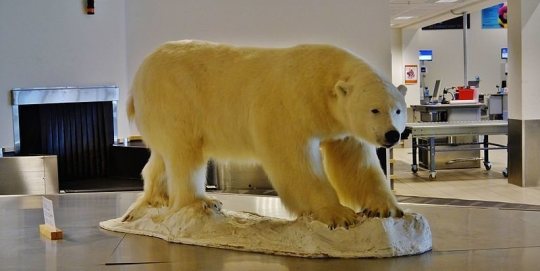
Zairon/CC BY-SA 4.0
Baggage Claim Polar Bear
Svalbard Airport (LYR)
“A taxidermied polar bear at the baggage claim in the Longyearbyen, Svalbard airport?” — penelopeashe
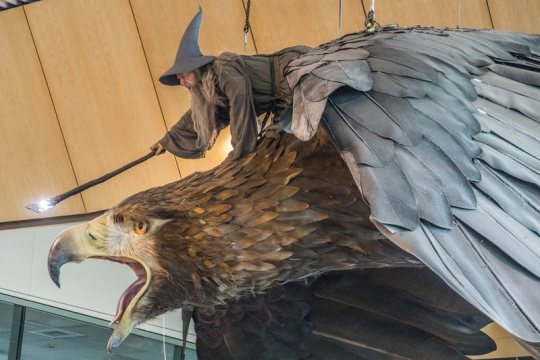
itravelNZ/CC BY 2.0
Lord of the Rings Features
Wellington International Airport (WLG)
“I love the Lord of the Rings theme at Wellington Airport in New Zealand.” — Taz_Coronado
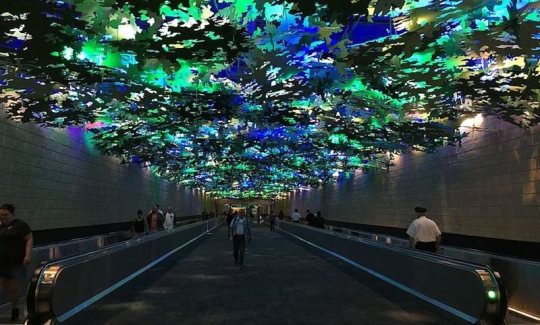
Djasc112/CC BY-SA 4.0
‘Flight Paths’
Hartsfield-Jackson Atlanta International Airport (ATL)
“The forest walk between Concourse A and B at Hartsfield-Jackson Airport in Atlanta.” — zamand

Dr. Raju Kasambe/CC BY-SA 4.0
The Gardens
Singapore Changi Airport (SIN)
“The Changi Airport in Singapore is almost a destination in of itself. [There’s a] butterfly hatchery in the butterfly garden, one of many gardens throughout the airport. There’s a water lily garden; a sunflower garden on one of the rooftops where you can grab some snacks and watch planes among hundreds of sunflowers; a fantastic cactus garden; an orchid garden; an arrival garden… Throughout are major art works, some are interactive. Very social media friendly.” — tpalms

delta82/Public Domain
Bamboo Tunnels
Deputado Luís Eduardo Magalhães International Airport (SSA)
“I particularly love this bamboo archway that welcomes you to the city of Salvador [in Brazil] right after you leave the airport (Deputado Luís Eduardo Magalhães International Airport). There’s one road leading in and one leading out—and yes, they’re both under individual bamboo arches.” — ravelmarques

Mike McBey/CC BY 2.0
Gibraltar International Airport (GIB)
“The most bizarre thing I’ve seen at an airport is in Gibraltar. To enter or leave the country by foot, car, or airport transfer, you have to cross the runway. When a plane is preparing for landing or take off, the barriers go down, traffic stops, and the runway is cleared.” — PinkyPea

Antonin/CC BY-SA 2.0
Tintin’s Rocket
Brussels Airport (BRU)
“Brussels is a glorious experience for anyone who loves The Adventures of Tintin. Hergé’s hero is everywhere (along with other Franco-Belgian comics icons like The Smurfs) and that extends to the airport. Before you blast off back home, admire the rocket from the Destination Moon and Explorers on the Moon albums…” — JamazingClayton
Responses have been edited for length and clarity.
The post 18 of the World’s Most Delightful Airport Features appeared first on Tripstations.
from Tripstations http://bit.ly/2Wvcea7
via IFTTT
0 notes
Video
youtube
Planning Committee (Wirral Council) 16th January 2020 Part 2 of 4
#Wirral Council#Wallasey Town Hall#Metropolitan Borough of Wirral#Planning Committee#councillors#planning applications#APP/19/01479#Lairds Sports Club 93 & Cammell Laird 1907 FC#APP/19/01157#Caldy Golf Club#APP/16/01455#Brimstage Hall#APP/19/01009#Mill House
0 notes
Text
London's iconic black cabs
Londoners or tourists visiting the UK's capital should not miss the opportunity to take a black taxi. This means of transport has survived for centuries, characterized by the subway and the double-decker bus. This feature and its recognizable appearance made them symbols of London.
The first version was introduced in the late 19th century. The model was a Bersey from 1897, known by the nickname "Hummingbird" because it made some noise. Many other taxi prototypes emerged after 1930. Some of the most important were the FX4, produced by Austin, and Metrocab, produced by Metropolitan Cammell Weymann.
The modern TX1 model replaced them in 1997, providing better accommodation for customers and also for taxi drivers. As noted, many black cabins have a common design: a 25-foot turning circle. It is said that these unique features were given at the round entrance to the well-known Hotel Savoy. Today, London taxis are even used as advertising tools. Many of them can be seen wrapped in colorful ads or during marketing events in England.
Another major need for change emerged in late 2010 when London Mayor Boris Johnson proposed an air quality strategy. I wanted to encourage taxi owners to buy low-emission vehicles, e.g. Electric taxis. Transport Minister Philip Hammond announced the same day financial support for electric vehicles at £ 5,000, a subsidy intended to motivate the transition to this less aggressive mode of transport.
As for the "life expectancy" of a black London taxi, it is reportedly in use for 10 or 12 years. After this period they continue to be used in transport, but in other cities in the UK which have different rules. Everyone else is bought by a car collector or ends up being forgotten in the owner's garages.
If you are traveling to London, official taxis (black taxis) are likely to be one of the first things you will see.
You need to end your experience with a tour of one of the city's black cabs located on the street and also at prominent places such as the main train station, subway and bus stations. The cabins are only available if the yellow TAXI sign on the front is lit.
Different taxi models.
You can choose from three taxi models of different shapes currently operating in the London area. One of them is The Fairway, which maintained the way everyone imagined it would be a London black cab , but is gradually being replaced by TX1 and TX2, which are the latest models. You can differentiate these taxis from the first because of the rounded shape that characterizes them. The last cabin model is the Metrocab, which has a square shape.
In addition to the different types of models that you can choose for your London trip, keep in mind that black cabins have achieved many improvements in passenger safety and driver comfort.
0 notes
Video
1971 - Belle of the ball by Bingley Hall
Via Flickr:
Unfortunately taken on dubious film stock, this transparency has not weathered the test of time well, but it's rarity value saves it. The 'Brighton Belle' electric Pullman service arrives at London's Victoria station with an up service from Brighton sometime during 1971. Three 5-car 750v DC, third rail, all Pullman electric multiple units were built for the Southern Railway in 1932 and worked the service in either single or double unit formations. It lost its classic umber and cream Pullman livery in 1969 and the service and units were withdrawn in April 1972.
#Transport#train#Transportation#Rail#railway#Railroad#electric#UK#Britain#England#Third rail#750V#DC#EMU#electric multiple unit#Brighton Belle#Pullman#5-BEL#Victoria#Metropolitan Cammell#Class 403#British Rail#BR#passenger#trainspam
3 notes
·
View notes
Video
The Blue Pullman train (Metropolitan Cammell) by Historical Railway Images
Via Flickr:
en.wikipedia.org/wiki/British_Rail_Classes_251_and_261
1 note
·
View note
Video
Jamaica Railway - Kingston train station - Diesel railcar (Metropolitan-Cammell) by Historical Railway Images
Via Flickr:
"A diesel train from Montego Bay arrives at Kingston Station. These Metropolitan-Cammell railcars are the latest thing on Jamaican railways" (May 1963)
2 notes
·
View notes
Video
Africa Railways - East African Railways - Mombasa station by Historical Railway Images
Via Flickr:
This type of coach was drawn by Metropolitan Cammell in late 1940 but was probably not delivered until after WW2. The coach is still in K&UR&H chocolate livery and the photo was taken between 1945 and 1950 given that stock would not all have been repainted in 1948 when EAR&H was formed
0 notes
Video
South African Railways - SAR Class 5E1 electric locomotives by Historical Railway Images
Via Flickr:
Production line of 35 South African Railways Class 5E1 electric locomotives built by Metropolitan Cammell Carriage & Wagon Company at Old Park Works, Wednesbury in 1960
0 notes



